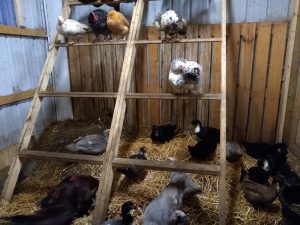What it IS and what IT ISN’T.
The Deep Litter method for poultry bedding is a favorite here at the Best Organic Homestead because it is natural, user friendly, labor saving, and healthy for our birds. But it seems like many poultry owners are confused about the Deep Litter method. I often run across this confusion in blogs and facebook posts. So let me clear this up.
The Deep Litter method is basically composting inside of your chicken run. What is needed to produce a true Deep Litter are the basic elements of good compost: a source of nitrogen, compostable materials such as straw, leaves, pine shavings, or hard wood pellets. Compost also needs oxygen and water. One must take care to not drench the compost with too much water because this will drown the bacterial organisms that break down the material and kill them by depriving them of oxygen. A litter deprived of oxygen thus grows anaerobic organisms, or organisms that grow without oxygen, and then becomes odorous, slimy, and sometimes produces toxic substances or mold. A litter that is anaerobic is bad for the health of the birds and doesn’t produce what it could to benefit the birds. Mold in the litter can produce respiratory illness in your birds and tends to inhibit the bacterial organisms that produce compost. If you’ve ever disturbed the bottom of a mucky pond, or found abandoned food enclosed tightly in a container then you’ve experienced what a disgusting mess anaerobic bacteria can leave behind. Fortunately, this issue is relatively easy to overcome.
The chickens or ducks provide the nitrogen with their feces. A lack of nitrogen usually isn’t an issue for Deep Litter among poultry owners. Chicken feces usually have very high levels of concentrated nitrogen while duck waste is more diluted because more water is included. This means, in general, that chicken feces take a bit longer to compost than duck waste into a garden friendly soil. Because of this, duck waste can be added to a garden directly without composting, while chicken waste needs a long composting period before use with plants.
A good Deep Litter should involve layering the poultry waste with fresh litter. Then the owner should periodically mix the layers to keep oxygen flowing throughout the layers. Chickens will help to mix some of the upper layers by scratching through the litter. Mixing isn’t absolutely necessary, but does speed up the process and ensures adequate oxygen throughout the layers. We mostly use straw here at the Best Homestead and find that this material composts relatively quickly and is light enough to mix pretty easily. Just for comparison, we also keep a large compost pile mostly derived from chicken waste and straw that is never mixed and after two years is fully composted and ready to be used for planting.
If ducks are involved there may be too much water in the litter. If this happens, raking the litter into piles so it can drain will probably help solve this problem. You can see one such pile in my photo. Eventually, I’ll spread this around and mix with the rest of the litter after it dries out. Also, putting pea gravel under water buckets might help. Increasing ventilation inside of the coop area is also another solution. As a last resort, the owner may have to remove soaked litter until the wetness level is acceptable when the old litter is mixed with new, fresh litter.
The first thing that I always do when entering a deep litter area is check for the smell of ammonia. If I can detect this, this gas level is already too dangerously high for the health of the bird’s lungs. The production of ammonia also means that there is too much nitrogen compared to litter or compostable material. It could also mean that the bacteria responsible for breaking down the compost hasn’t caught up with the level of nitrogen from the feces yet. The answer is to add more compostable material to the mix, or even add some old compost to the mix to get the process started. Increasing ventilation to the area is also a good idea. It’s also possible that the owner might have too many birds for the area. Composting material should smell earthy, or like humus-like dirt and never foul, like mold or ammonia, or have the stench of the inside of a porta-potty.
A good Deep Litter can take anywhere from a week to a few months to really get rolling. It may take longer in winter, but it will eventually get going. In winter, a good deep litter has the advantage of producing heat while composting.
The other advantage of Deep Litter is that after the compost starts going, and especially if you are raising your birds on dirt, there will be many small edible creatures thriving in the compost. These will provide an outstanding source of insect, and other invertebrate protein for your birds. This shouldn’t be discounted because chickens are actually omnivores these critters provide food that is closer to their natural diet.
To get your Deep Litter started, the owner should add compostable materials to a layer of litter already coated with feces. But don’t wait until the amount of feces is strong enough to produce an ammonia smell. The owner should mix or turn the litter every week, or even twice a week, to oxygenate the litter. Water may need to be added to keep things slightly damp. Keep adding litter to this mix as long as wanted. The full Deep Litter may be a thick as 3 feet and still be viable.
What Deep Litter Isn’t:
Since the aim is to allow the litter layers to actually have time to compost, produce some heat, and grow some edible critters for your birds, the owner can’t add a few layers then remove the entire mix. Some practitioners will do this, defeating the entire concept of Deep Litter. Basically what they are doing is just adding new litter to old to reduce the odor and the make their litter last longer. There is nothing wrong with this, but this isn’t the true Deep Litter method. And these owners are missing out on the benefits of true Deep Litter.
Deep Litter also isn’t allowing wet litter to accumulate into a slimy, thick, almost crust-like layer that’s super hard to lift and move. Usually, this has become anaerobic (without oxygen) and isn’t composting because it’s water-logged. This is a dangerous situation for your birds because the mold produced can actually cause disease in your birds, and this can also be a problem for your lungs.
I hope this clears up the useful Deep Litter method for you. Let us know your strategies for Deep Litter, your challenges and your triumphs.





